COPYRIGHT, PLEASE NOTE
Wednesday, December 21, 2022
Milky Way, 12 years, 1250 hours of exposures and 125 x 22 degrees of sky
https://astroanarchy.zenfolio.com/
It took nearly twelve years to collect enough data for this high resolution gigapixel class mosaic image of the Milky Way. Total exposure time used is around 1250 hours between 2009 and 2021.
" I can hear music in this composition, from the high sounds of sparcs and bubbles at left all the way to a deep and massive sounds at right."
The final photo is about 100 000 pixels wide, it has 234 individual mosaic panels stitched together and 1,7 gigapixels. (Click for a large image) All the frames used are marked in this image. Since many of sub-images and mosaics are independent artworks it leads to a very complex mosaic structure.
NEW, A HD-video from Germany shows my photo in full glory
https://www.youtube.com/watch?v=D-Z60eZ4yqM
(Video in Germany but images are the international language)
Close ups form the parts of the Grande Mosaic
The California Nebula, NGC 1499, can be seen at bottom left of the large mosaic image.
There are about 20 million individual stars visible in the whole mosaic image.
Click for a large image
Image spans 125 x 22 degrees of the Milky About 20 million individual stars are visible in my photo!
My processing workflow is very constant so very little tweaking was needed between the mosaic frames. Total exposure time is over 1250 hours. Some of the frames has more exposure time, than others. There are some extremely dim objects clearly visible in this composition, like a extremely dim supernova remnant W63, the Cygnus Shell. It lays about six degrees up from North America nebula and it can be seen as a pale blue ring. I spent about 100 hours for this SNR alone. An other large and faint supernova remnant in Cygnus can be seen at near right edge of the image. G65.5+5.7 is as large as more famous Veil nebula. There are over 60 exposure hours for this SNR alone. (Veil SNR is just outside of the mosaic area for compositional reasons but can be seen in "Detail" image above.)
I took my current toolset as a base tool since it has a relatively high resolution combined to a very large field of view. Also it collects photons very quickly since it's undersampled and I can have very dim background nebulosity visible in very short time (many times 30 min frame is enough)
I do all my mosaic work under the PhotoShop, Matching the separate panels by using stars as an indicator is kind of straight forward work. My processing has become so constant, that very little tweaking is needed between separate frames, just some minor levels, curves and color balance.
I have used lots of longer focal length sub-frames in my mosaic to boost details. (See the mosaic map at top of the page) To match them with shorter focal length shots I developed a new method.
Firstly I upscale the short focal length frames about 25% to have more room for high resolution images.Then I match the high res photo to a mosaic by using the stars as an indicator. After that I remove all the tiny stars from the high res image. Next I separate stars from low res photo and merge the starless high res data to a starless low res frame. And finally I place the removed low res stars back at top of everything with zero data lost. Usually there are some optical distortions and it's seen especially in a star field. Now all my stars are coming from a same optical setup and I don't have any problems with distortions. (I'm using the same star removal technique as in my Tone Mapping Workflow)
Click for a large image
Click for a large image,
IC 405 6 410 area
The blog post with technical details can be seen here, https://astroanarchy.blogspot.com/2020/10/the-tulip-nebula-in-cygnus-sh2-101.html
Saturday, March 29, 2008
Sh2-240 with more photons.

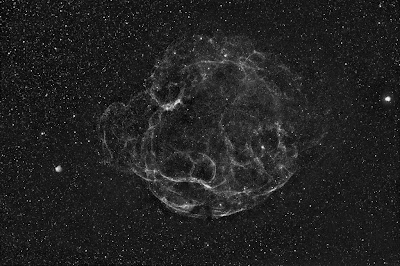
Hydroge alpha channel only
-
Update:
I reprocessed images, and I was able to go litle deeper, I think.
The data is yet "thin" and more exposures are needed, maybe an other ten hours.
Friday, March 28, 2008
Sh2-129
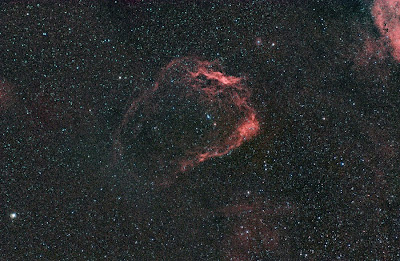

Tuesday, March 25, 2008
IC 1396 in Color
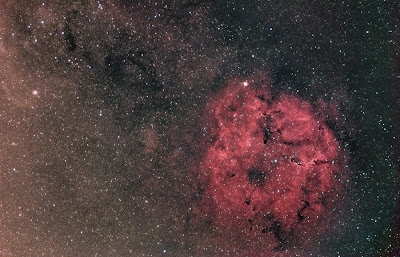
Friday, March 21, 2008
IC 443 & NGC 2175
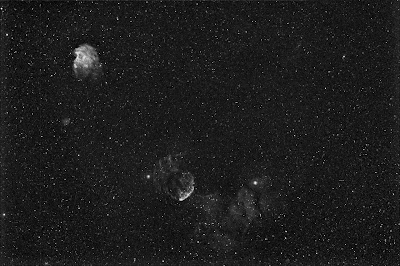
Thursday, March 20, 2008
IC 1396 & Dark nebulas in Hydrogen Alpha light
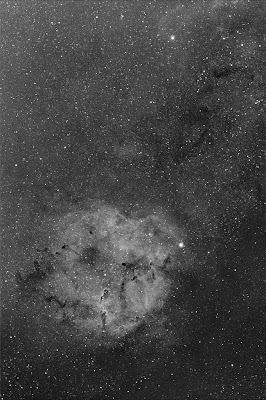 After playing with 3D stuff I returned back to real astro imaging.
Last night was allmost full Moon and doe that I selected the target from opposite side of the sky.
IC 1396 was about 30-36 degrees above horizont during the capturing.
IC 1396 is a large emission nebula. Image scale fits well with field of view
of Canon FD 200mm f2.8 lens. There is lots of faint nebulosity around the field.
Dark nebulas, visible in image, are dark hydrogen clouds and
they are blocking light from background stars.
One part of the large nebula is a famous "Elephant's Trunk Nebula", seen in lower
part of the image.
After playing with 3D stuff I returned back to real astro imaging.
Last night was allmost full Moon and doe that I selected the target from opposite side of the sky.
IC 1396 was about 30-36 degrees above horizont during the capturing.
IC 1396 is a large emission nebula. Image scale fits well with field of view
of Canon FD 200mm f2.8 lens. There is lots of faint nebulosity around the field.
Dark nebulas, visible in image, are dark hydrogen clouds and
they are blocking light from background stars.
One part of the large nebula is a famous "Elephant's Trunk Nebula", seen in lower
part of the image. Elephant's Trunk detail from 10.12.2007
Older image of the "Elephant's Trunk", with longer FL
This formation can be seen in upper image. (lower part of the picture).
LX200 GPS 12" f6.3 + SXV-AO (Active Optics system) H-a 4h Elephants trunk nebula in IC 1396
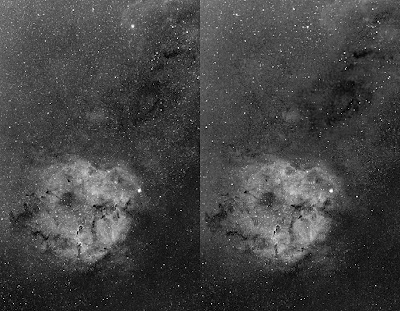 Parallel Vision Stereo Image
Parallel Vision Stereo Image
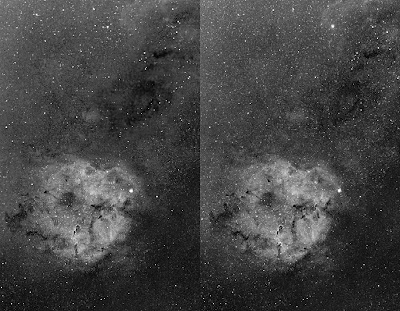 Cross Vision Stereo Image
Cross Vision Stereo Image
Saturday, March 8, 2008
Sh2-240, four more hours.
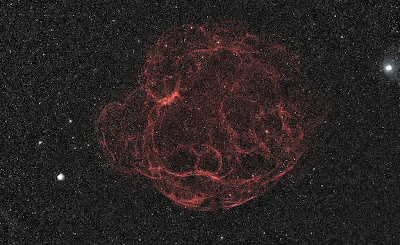
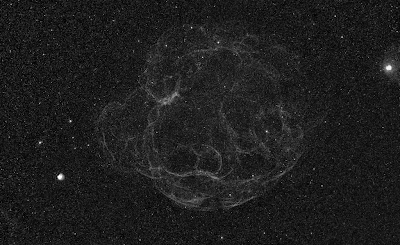
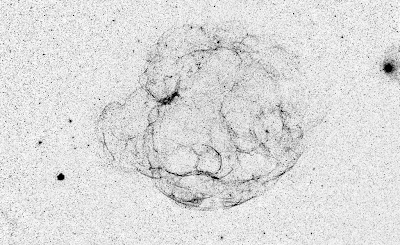 Inverted version
Inverted version Thursday, March 6, 2008
Sh2-240 (Simeis 147)
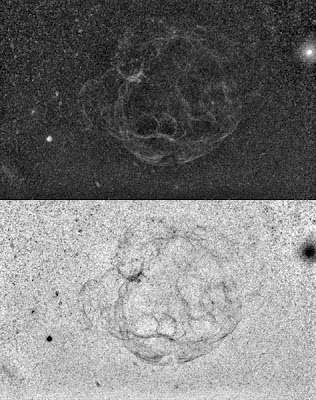
Wednesday, February 27, 2008
IC 405 & IC410
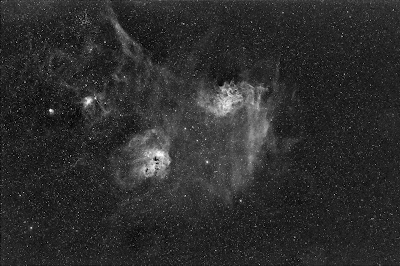
Friday, February 15, 2008
Second light for Canon FD 200mm f2,8 lens
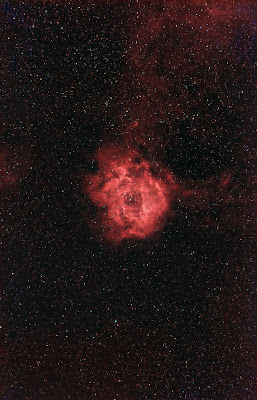
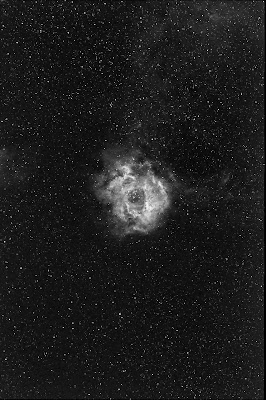
Thursday, February 14, 2008
First light, Canon FD 200mm f2.8 lens
 I added some color, but there was problem with camera orientation, so image is clipped.
I added some color, but there was problem with camera orientation, so image is clipped.
Color data: only 3x600s with UHC-s filter
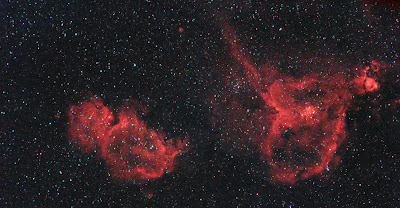
I shoot California nebula as well. Elevation was very low at the end of the exposures,
only about 28 degrees.
H-alpha 4x900s, same setup.
Color version:
3x600s trough UHC-filter added.
 Over all, I'm veryhappy with this lens. This is very first time to me use camera lens
Over all, I'm veryhappy with this lens. This is very first time to me use camera lens
for astro photography.
I was expecting severe distortion in the image edges, there is none!
I was expecting severe color aberration, there is none!!!
This lens was unexpencive, doe the old FD model, about 120€.
 Here is the link for moreinformation:
http://www.mir.com.my/rb/photography/companies/canon/fdresources/fdlenses/200mm.htm
All the images are shooted with full f2.8 aperature.
Here is the link for moreinformation:
http://www.mir.com.my/rb/photography/companies/canon/fdresources/fdlenses/200mm.htm
All the images are shooted with full f2.8 aperature.
The front lens aperature is 72mm.
FOCUSING Fast lenses are very difficult to focus manually, it's pure luck to reach sharp focus. 200mm f2.8 lens has about 20 microns sharp focus area! I build a simple autofocuser to my lens by using TCF-s temperature compensating focuser. I'll send real pictures about that later. Here is a picture about principle. This system solves allso problems with focus temperature shift!
TCF-s focuser is easy to move back to the main telescope at anytime.
I was able to use FocusMax with the lens and reach sharp focus in 30 seconds.
This system solves allso problems with focus temperature shift!
TCF-s focuser is easy to move back to the main telescope at anytime.
I was able to use FocusMax with the lens and reach sharp focus in 30 seconds.


























